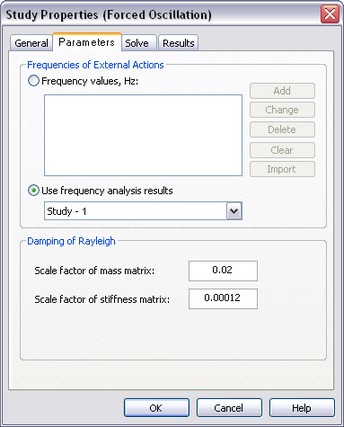 |
AutoFEM Analysis Settings of Oscillation Solver | ||||||
Settings of the processor of forced oscillations analysis
In tab [General], it is possible to determine or change the descriptive properties of the current study; that is: name, type of study, and comment.
In the tab [Parameters], it is possible to determine or change frequencies of external action, parameters of Rayleigh damping.

In the group of parameters “Frequencies of external action”, values of frequencies pertaining to actions of external loads are established. There several ways of adding new values:
1.Button [Add] allows the addition of both the single value of the frequency and a frequency range, for which the initial value, end value and gain are specified.

2.Button [Import] brings out the dialogue window in which values of resonance frequencies can be imported out of results of the earlier performed frequency analysis.

3.When it is required to calculate the forced oscillations only at all resonance frequencies, determined via the earlier frequency analysis, you should activate the control element “Use frequency analysis results.” Here, the associative connection with the results of the selected frequency analysis is maintained, i.e. at the change of frequency analysis results, the values of updated own values will be automatically used for the forced oscillation analysis.
Over the existing list of frequency values, the following edit operations are available:
•button [Change] permits to re-write the value of single specific value;
•button [Remove] removes the selected frequency value from the list;
•button [Clear] clears off the whole list of frequency values.
In the group of parameters “Rayleigh damping”, the values of damping factors of the structure a and b are defined.
Tab [Solve] permits to set the processor’s properties for the solution of a system of equations. Parameters, defining the settings of the processor, are similar to those in the Static Analysis.
Tab [Results] allows one to determine the types of results, displayed in the study tree upon the calculation.
See also: Forced Oscillation Analysis, Theory Background, Specific Pre-Processor Settings, Steps of Oscillation Analysis, Analysing Results